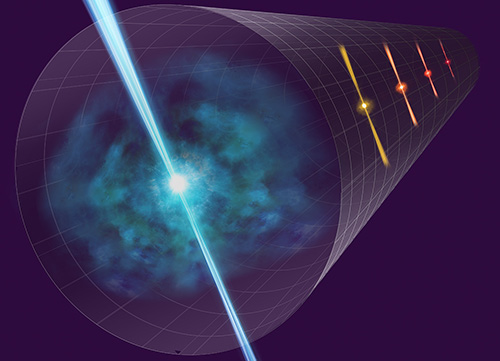Campus News
Measuring the universe with star-shattering explosions
An international team of scientists has analyzed archive data for powerful cosmic explosions from the deaths of stars and found a new way to measure distances in the distant universe.

An international team of scientists has analyzed archive data for powerful cosmic explosions from the deaths of stars and found a new way to measure distances in the distant universe.
Led by Maria Dainotti at the National Astronomical Observatory of Japan (NAOJ), the team includes J. Xavier Prochaska and Enrico Ramirez-Ruiz, both professors of astronomy and astrophysics at UC Santa Cruz. Prochaska and Ramirez-Ruiz contributed to the design, fabrication, and commissioning of the Reionization and Transients Infrared/Optical (RATIR) imager on the 1.5-meter telescope at the San Pedro Martir Observatory. Data from RATIR played a key role in the new study.
“This work makes terrific use of the RATIR telescope, a partnership between the University of California, Arizona State, and Universidad Nacional Autónoma de México,” Prochaska said.
With no landmarks in space, it is very difficult to get a sense of depth. One technique astronomers use is to look for “standard candles,” objects or events where the underlying physics dictate that the absolute brightness (what you would see if you were right next to it) is always the same. By comparing this calculated absolute brightness to the apparent brightness (what is actually observed from Earth), it is possible to determine the distance to the standard candle, and by extension other objects in the same area.
The lack of standard candles bright enough to be seen more than 11 billion light-years away has hindered research on the distance universe. Gamma-ray bursts (GRBs)—bursts of radiation produced by the deaths of massive stars—are bright enough, but their brightness depends on the characteristics of the explosion.
Embracing the challenge of attempting to use these bright events as standard candles, the team analyzed archived data for the visible light observations of 500 GRBs taken by world-leading telescopes, including RATIR, the Subaru Telescope (owned and operated by NAOJ), and satellites such as the Neil Gehrels Swift Observatory. Studying the light curves showing how the GRBs brightened and dimmed over time, the team identified a class of 179 GRBs which have common features and have likely been caused by similar phenomena. From the characteristics of the light curves, the team was able to calculate a unique brightness and distance for each GRB which can be used as a cosmological tool.
These findings will provide new insights into the mechanics behind this class of GRBs, and provide a new standard candle for observing the distant universe. Lead author Dainotti had previously found a similar pattern in x-ray observations of GRBs, but visible light observations have been revealed to be more accurate in determining cosmological parameters.
These results appeared as Dainotti et al., “The Optical Two and Three-Dimensional Fundamental Plane Correlations for Nearly 180 Gamma-Ray Burst Afterglows with Swift/UVOT, RATIR, and the SUBARU Telescope,” in the Astrophysical Journal Supplement on July 22, 2022.